This article was co-authored by Joshua Grahlman, PT, DPT, FAFS. Dr. Joshua Grahlman, PT, DPT, FAFS, is the Founder and Chief Athlete Mechanic of Clutch PT + Performance, a private physical therapy clinic specializing in sports and orthopedics in New York City. With more than a decade of experience, Dr. Grahlman specializes in treating acute and chronic pain and injuries, sports performance optimization and post-operative rehabilitation. Dr. Grahlman earned his Doctorate of Physical Therapy (DPT) from Columbia University College of Physicians and Surgeons. He is one of just a few DPTs in New York City recognized as a Fellow in Applied Functional Science through the Gray Institute for Functional Transformation (GIFT). He is certified in Active Release Technique and Spinal Manipulation and is a TRX Suspension Training Specialist. Dr. Grahlman has spent his career treating athletes of all levels, from Ironman Champions and Olympians to marathoner moms. He consults for Triathlete, Men’s Health, My Fitness Pal and CBS News.
There are 8 references cited in this article, which can be found at the bottom of the page.
wikiHow marks an article as reader-approved once it receives enough positive feedback. In this case, 95% of readers who voted found the article helpful, earning it our reader-approved status.
This article has been viewed 608,974 times.
Ankle sprains are very common. A sprain occurs when you roll or twist your ankle in an odd way, stretching or even tearing a ligament on the outside of your ankle. If left untreated, an ankle sprain can lead to long-term problems; however, most sprains can be treated with the RICE (Rest, Ice, Compression, Elevate) method. The steps below show you how to properly execute the compression step in treating a sprained ankle.[1] [2] [3]
Steps
Getting Ready to Wrap the Ankle
-
1Pick your bandage. For most people, the best choice of wrapping for a compression wrap is a cloth elastic bandage, sometimes colloquially known as an “ACE bandage,” after a common brand of elastic bandage.
- Any brand of elastic bandage will work. However, wider bandages (between one-and-half and three inches wide) are usually easier to use.
- Cloth elastic bandages are comfortable, since they're made of stretchy cloth. This can help if your ankle starts swelling since the fabric will stretch.[4] They are also reusable. (When you're finished, you can wash it and use it again when you need it.)
- Some bandages come with metal clips for fastening the end of the wrap. If yours does not include metal clips, medical tape can also be used to secure the end of the bandage when the wrap is complete. You can also securely tuck the end of the bandage into the wrap.
-
2Prepare the bandage. If your elastic bandage is not already wrapped, roll the bandage into a tight coil.[5]
- Compression wraps should fit against the foot and ankle snugly, so it helps to have the cloth wrap coiled tightly from the beginning, making it less likely that you will need to stretch and readjust the bandage as you go.
Advertisement -
3Position the bandage. Always wrap a bandage starting at the furthest part of your body—in this case, the bottom of your ankle.[6] If you are wrapping your own ankle, it may be easier to position the rolled bandage on the inside of your foot. If you are wrapping someone else’s ankle, it may be easier position the rolled bandage on the outside of the foot.
- In either case, it’s crucial that coil face away from the foot, so that the coiled portion of the bandage is on the outside of the foot as you wrap it.
- For example, if you think of the coiled bandage as a roll of toilet paper and the foot as a wall, the coiled bandage should be in an “under” orientation.[7]
-
4Add extra padding, if necessary. For extra support, you can place a gauze pad on either side of the ankle before wrapping. Horseshoe-shaped padding cut from foam or felt is also used for extra stability in compression wraps.[8]
Wrapping With Athletic Tape
-
1Decide if athletic tape is right for you. In most cases, it’s best to use a cloth bandage to wrap a sprain; however, some individuals engaged in athletic activity, such as running, prefer the feel of athletic tape.
- While athletic tape works to wrap an injured ankle, it is primarily made to wrap an uninjured joint before activity to avoid injury, not to protect an already injured ankle.
- Even though the thinner, sturdier athletic tape makes continued activity easier than the bulkier, more flexible cloth bandage, continued athletic activity on a sprained ankle is not advised.[9]
-
2Begin with an underwrap. Underwrap is a nonadhesive material used to wrap the foot and ankle before the tape is applied, so that the tape doesn't pull at the surface of the skin. Starting at the ball of the foot, wind the underwrap around the foot up to the ankle, leaving the heel uncovered.
- Underwrap is available at drugstores and sporting goods stores.
- It is possible to tape an ankle without underwrap, but it is much less comfortable.
-
3Secure the anchor. Cut a strip of tape long enough to wrap 1 1/2 times around your ankle. Wind it around your ankle, over the underwrap, to hold the underwrap in place. This is called the anchor, since it anchors the rest of the taping in place.
- If the ankle has a lot of hair, it can be shaved so that the tape doesn't stick to it.
- If necessary, use a second piece of tape to make sure the underwrap is secure.
-
4Create a stirrup. Place the end of a piece of tape on one side of the anchor. Bring it down under the arch of the foot and back up to the other side of the anchor. Press it lightly to secure it in place.
- Repeat with two more pieces of tape overlapping the first one to create a sturdy stirrup.
-
5Create an "x" over the foot. Place the end of a piece of tape at the ankle bone and run it diagonally over the top of the foot. Bring it down under the arch and toward the inside of the heel. Then bring it around the back of the heel and back up over the foot to create the other part of the "x."
-
6Make a figure eight. Place the end of a piece of tape on the outside of the ankle, just above the bone. Run it over the top of the foot at an angle, then bring it under the arch and up the other side of the foot. Next bring it around the ankle and back to the point where you started.
- Repeat the figure eight. Use another piece of tape to make a second figure eight that overlaps the first one. This will ensure that the wrap is held securely in place and provides enough support for the ankle to heal properly.
Wrapping with an Elastic Cloth Bandage
-
1Begin wrapping. Place the end of the bandage where the toes meet the foot. Begin by wrapping the bandage around the ball of the foot. Hold the end of the bandage against the ball of the foot with one hand, and use the other to bring the tail around the foot from the outside.
- Start wrapping loosely, and overlap about 50% of the bandage on each pass.[10]
You can wrap the top layers more tightly if you need more stability.
-
1Work your way up toward your ankle. Wrap the ball of the foot twice, to hold the bandage in place, then begin moving up towards the ankle, being sure to leave at least one-half inch of bandage overlapping the previous layer.
- Make sure the layers are smooth and even with no unnecessary bulges or lumps. Start over if you need to do the job more neatly.
- By working from the furthest part of your ankle and moving upward, you'll avoid creating a tourniquet effect where the bandage cuts off circulation to your foot.[11]
-
2Wrap the ankle. When you get to the ankle, bring the end of the bandage up outside of the foot, over the instep and around the inside of the ankle. Then bring it around the heel, back up over the instep, under the foot, and around the ankle.
- Continue making this “figure eight” around the ankle several times to fully stabilize the ankle.
-
3Finish the wrap. The last wrap should rise several inches above the ankle to help stabilize it.
- Make sure not to wrap the bandage too tightly, or else it could cut off circulation.[12]
- Use the metal fasteners or medical tape to secure the remaining bandage. Excess bandage can also be tucked under the last layer of bandage, provided there’s not too much excess.
- If you are wrapping a child's ankle, there may be too much excess bandage, and it will have to be cut.
Expert Q&A
Did you know you can get expert answers for this article?
Unlock expert answers by supporting wikiHow
-
QuestionWhat can I do to make my ankle heal faster while it's wrapped?
 Catherine Cheung, DPMDr. Catherine Cheung is a board certified Podiatrist based in San Francisco, California. Dr. Cheung specializes in all aspects of foot and ankle care, including complex reconstruction. Dr. Cheung is affiliated with the Brown & Toland Physicians and the Sutter Medical Network. She earned a DPM from the California College of Podiatric Medicine, completed her residency at the Encino Tarzana Medical Center, and completed a fellowship at the Kaiser Permanente San Francisco Medical Center. She is board certified by the American Board of Podiatric Surgery.
Catherine Cheung, DPMDr. Catherine Cheung is a board certified Podiatrist based in San Francisco, California. Dr. Cheung specializes in all aspects of foot and ankle care, including complex reconstruction. Dr. Cheung is affiliated with the Brown & Toland Physicians and the Sutter Medical Network. She earned a DPM from the California College of Podiatric Medicine, completed her residency at the Encino Tarzana Medical Center, and completed a fellowship at the Kaiser Permanente San Francisco Medical Center. She is board certified by the American Board of Podiatric Surgery.
Board Certified Podiatrist
-
QuestionHow do I wrap a sprained ankle?
 Joshua Grahlman, PT, DPT, FAFSDr. Joshua Grahlman, PT, DPT, FAFS, is the Founder and Chief Athlete Mechanic of Clutch PT + Performance, a private physical therapy clinic specializing in sports and orthopedics in New York City. With more than a decade of experience, Dr. Grahlman specializes in treating acute and chronic pain and injuries, sports performance optimization and post-operative rehabilitation. Dr. Grahlman earned his Doctorate of Physical Therapy (DPT) from Columbia University College of Physicians and Surgeons. He is one of just a few DPTs in New York City recognized as a Fellow in Applied Functional Science through the Gray Institute for Functional Transformation (GIFT). He is certified in Active Release Technique and Spinal Manipulation and is a TRX Suspension Training Specialist. Dr. Grahlman has spent his career treating athletes of all levels, from Ironman Champions and Olympians to marathoner moms. He consults for Triathlete, Men’s Health, My Fitness Pal and CBS News.
Joshua Grahlman, PT, DPT, FAFSDr. Joshua Grahlman, PT, DPT, FAFS, is the Founder and Chief Athlete Mechanic of Clutch PT + Performance, a private physical therapy clinic specializing in sports and orthopedics in New York City. With more than a decade of experience, Dr. Grahlman specializes in treating acute and chronic pain and injuries, sports performance optimization and post-operative rehabilitation. Dr. Grahlman earned his Doctorate of Physical Therapy (DPT) from Columbia University College of Physicians and Surgeons. He is one of just a few DPTs in New York City recognized as a Fellow in Applied Functional Science through the Gray Institute for Functional Transformation (GIFT). He is certified in Active Release Technique and Spinal Manipulation and is a TRX Suspension Training Specialist. Dr. Grahlman has spent his career treating athletes of all levels, from Ironman Champions and Olympians to marathoner moms. He consults for Triathlete, Men’s Health, My Fitness Pal and CBS News.
Physical Therapist & Entrepreneur
Things You'll Need
- Ace bandage
- Medical or athletic tape
- Underwrap
- Scissors
References
- ↑ https://www.aofas.org/footcaremd/how-to/foot-injury/Pages/How%20to%20Care%20for%20a%20Sprained%20Ankle.aspx
- ↑ http://www.webmd.com/a-to-z-guides/ankle-sprain-overview
- ↑ http://www.webmd.com/a-to-z-guides/ankle-sprain-treatment-overview
- ↑ Catherine Cheung, DPM. Board Certified Podiatrist. Expert Interview. 21 April 2020.
- ↑ http://www.webmd.com/first-aid/applying-a-compression-wrap-for-a-sprained-ankle
- ↑ Joshua Grahlman, PT, DPT, FAFS. Physical Therapist & Entrepreneur. Expert Interview. 8 September 2020.
- ↑ http://www.cnet.com/news/over-or-under-the-science-of-toilet-paper-orientation
- ↑ Catherine Cheung, DPM. Board Certified Podiatrist. Expert Interview. 21 April 2020.
- ↑ http://www.runnersworld.com/injury-treatment/taping-a-sprained-ankle
- ↑ Joshua Grahlman, PT, DPT, FAFS. Physical Therapist & Entrepreneur. Expert Interview. 8 September 2020.
- ↑ Joshua Grahlman, PT, DPT, FAFS. Physical Therapist & Entrepreneur. Expert Interview. 8 September 2020.
- ↑ Catherine Cheung, DPM. Board Certified Podiatrist. Expert Interview. 21 April 2020.
- ↑ Catherine Cheung, DPM. Board Certified Podiatrist. Expert Interview. 21 April 2020.
About This Article
To treat and wrap a sprained ankle, start by placing a gauze pad on either side of the ankle. Then, wrap a cloth elastic bandage snugly around the ball of the foot twice. Next, work your way towards your ankle, overlapping the bandage at least by 1/2 inch as you go. When you get to the ankle, wrap the bandage around the heel, over the instep, and under the foot. Finish by securing the bandage a few inches above the ankle with medical tape. For more advice from our Medical co-author, including how to wrap a sprained ankle using athlete’s tape, keep reading!
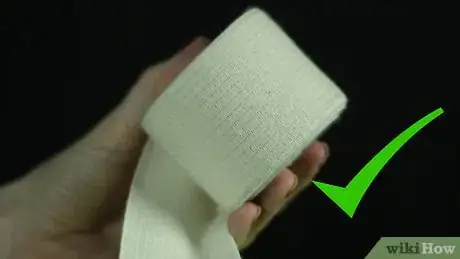


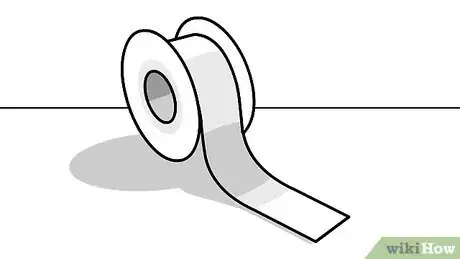
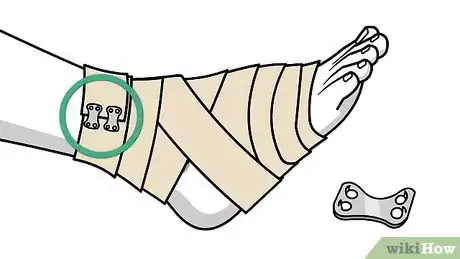

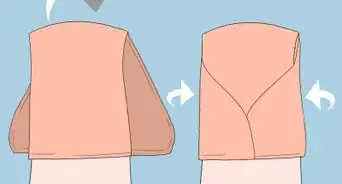

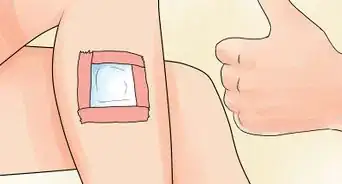

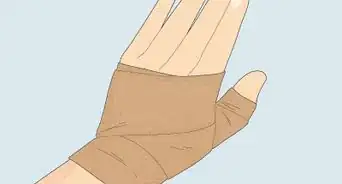


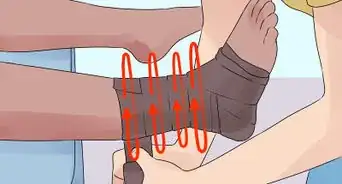
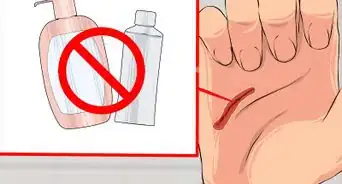
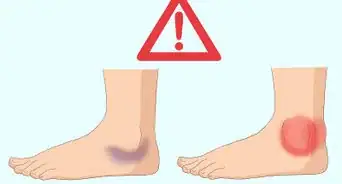


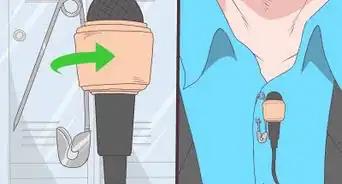









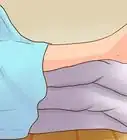
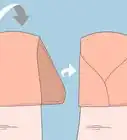

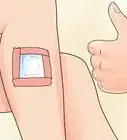



































Medical Disclaimer
The content of this article is not intended to be a substitute for professional medical advice, examination, diagnosis, or treatment. You should always contact your doctor or other qualified healthcare professional before starting, changing, or stopping any kind of health treatment.
Read More...